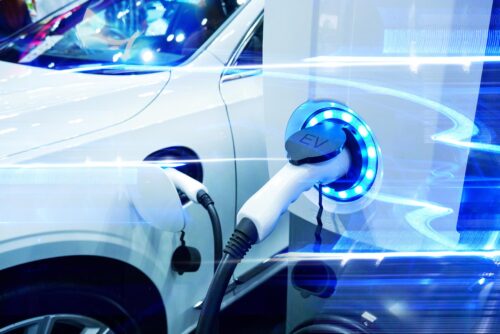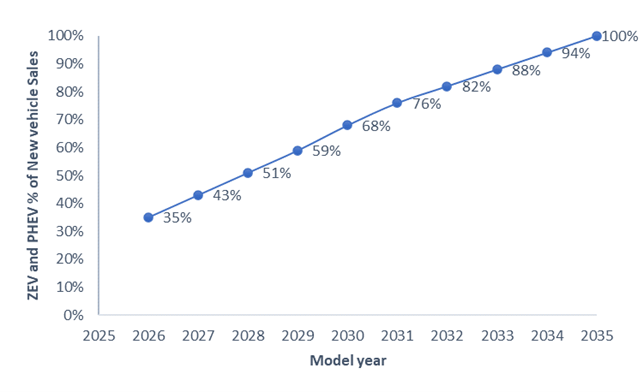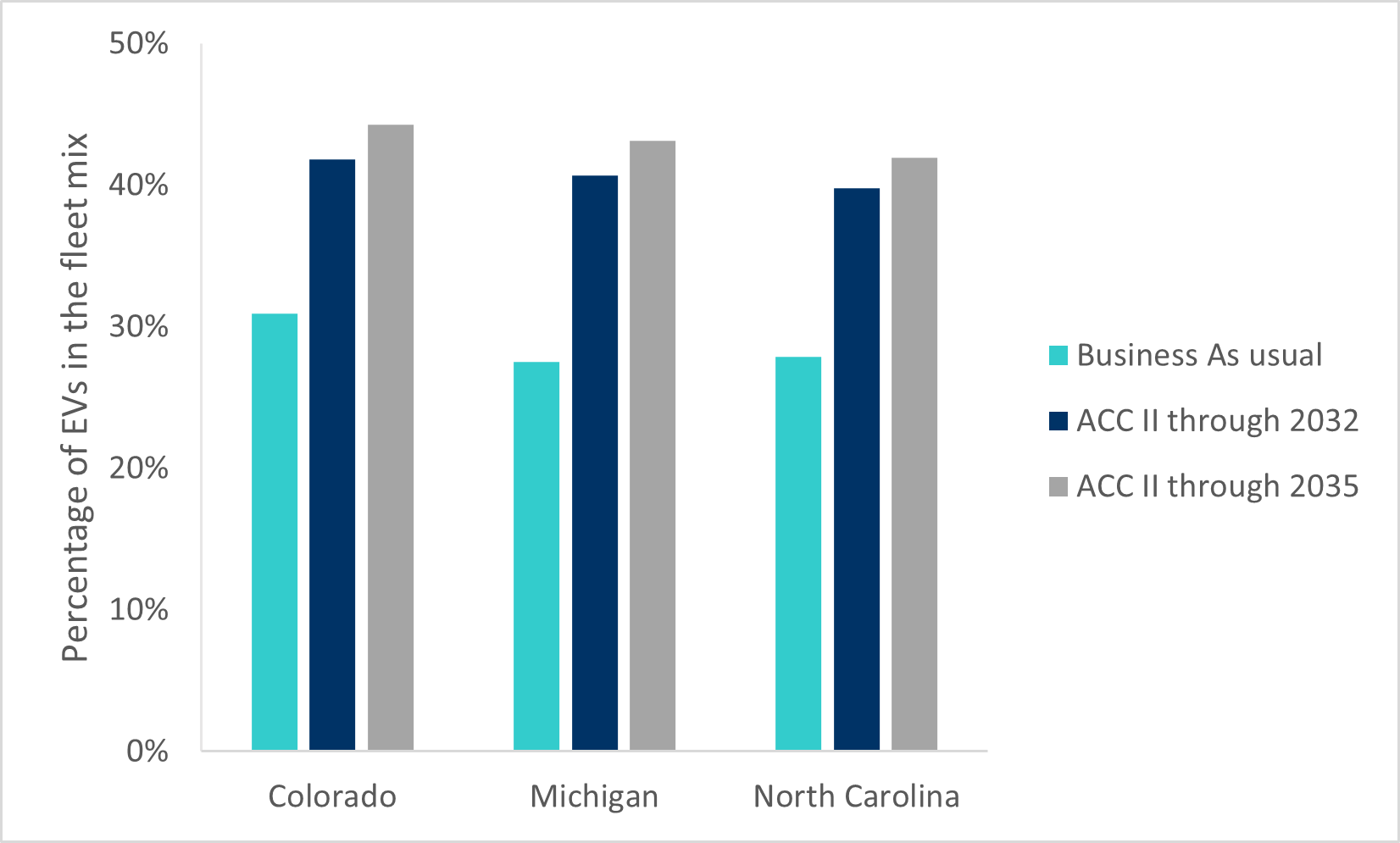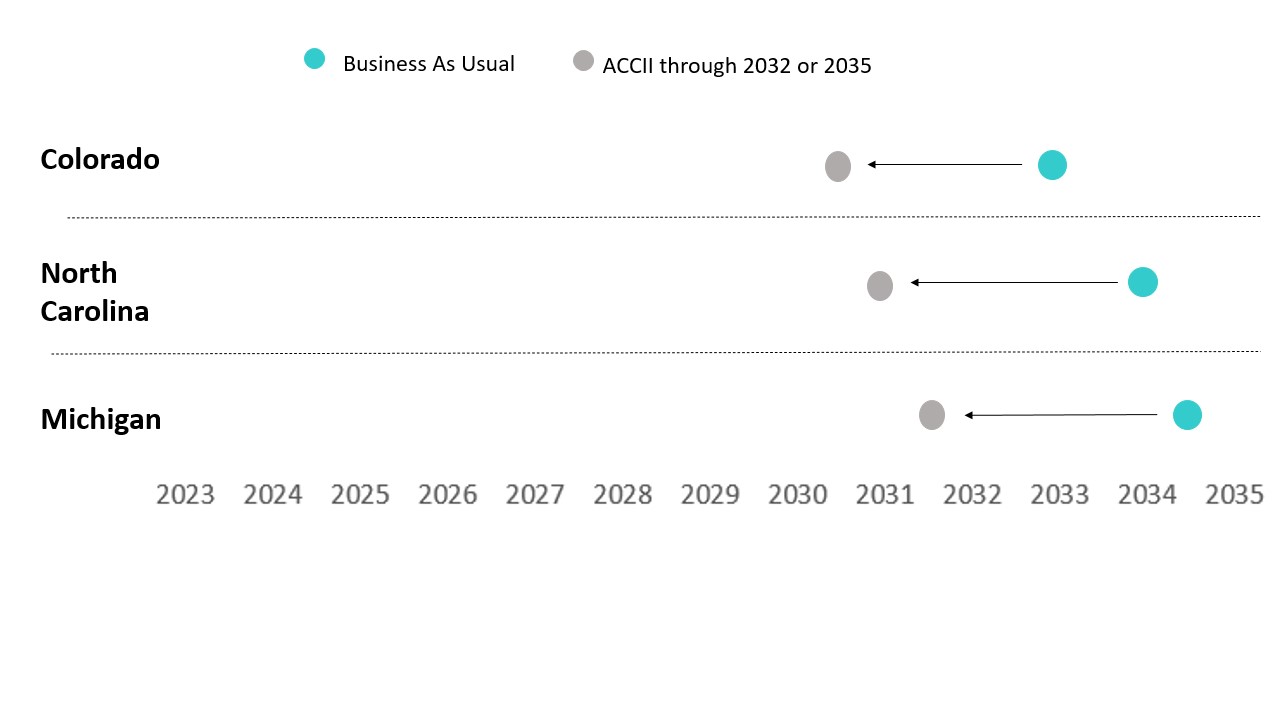
Advanced Clean Cars II: Cutting Pollution while Strengthening Local Economies
The Advanced Clean Cars II rule (ACC II), a regulation first promulgated in California, regulates electric vehicle (EV) sales and works to further control vehicle emissions. ACC II can significantly increase the proportion of EVs in the US vehicle fleet, leading to substantial economic, health, and emissions reduction benefits.
State governments are now considering whether to follow California’s lead in setting a regulation to increase EV sales and decrease fossil fuel vehicle sales through 2035, with Colorado recently indicating in their 2023 EV Plan that they plan to adopt ACC II sales requirements through 2032 only.
RMI evaluated the impacts of full and partial adoption of ACC II in Colorado, Michigan, and North Carolina. We found these states can maximize the possible benefits of the regulation with full adoption. However, even partial adoption of ACC II can yield significant benefits and could lead to an important EV market tipping point.
ACC II provides a way for states to adopt more ambitious vehicle standards
Under the Clean Air Act, California is allowed to set vehicle air pollution standards that are more aggressive than federal standards, which other states can also adopt. California adopted the Advanced Clean Car II rule (ACC II) in 2022, and since then, several other states across the country are promulgating the rule, including New York, Washington, Massachusetts, and Oregon.
The regulation seeks to reduce transport emissions and increase zero-emission vehicle (ZEV) sales (the regulation defines ZEVs as EVs and fuel cell electric vehicles, known as FCEVs). This analysis focuses on the sale of EVs as the sale of FCEVs is marginal in comparison. ACC II requires auto manufacturers to sell an increasing percentage of EVs over time and stipulates a 35 percent sales requirement in 2026, ramping up to a 100 percent sales target in 2035 (See Exhibit 1).
States across the country can meet federal standards or adopt California’s vehicle standard. If they choose to adopt California’s standard, they must follow California’s compliance mechanisms, however, they have discretion in determining when the regulation comes into effect and whether to carry the sales targets through 2035 or a model year prior. For example, Colorado is considering partial adoption of ACC II sales targets through 2032, rather than all the way through 2035.
Exhibit 1: ACC II Annual Zero-Emission Vehicle Sales Requirements

States Like Colorado, Michigan, and North Carolina would benefit greatly from adopting ACC II
RMI evaluated the impacts from full and partial ACC II adoption in Colorado, Michigan, and North Carolina, all three of which have set goals to reduce economy-wide greenhouse gas (GHG) emissions by between 90 to 100 percent by 2050. Increasing the deployment of electric vehicles while phasing out fossil fuel vehicles will be a necessary component to achieving state GHG emissions reduction goals. Without accelerating and sustaining the deployment of EVs this decade, it will become extremely difficult to meet 2050 GHG reduction goals.
Michigan, with its historical ties to the auto industry, and North Carolina, with its fast-growing population, are well situated to examine ACC II adoption and consider Colorado’s proposed path of partial adoption.
ACC II adoption can lead to economic and environmental benefits while helping these states achieve their emission reduction targets. By adopting ACC II fully, these three states can reduce their GHG emissions by an additional 40 percent by 2050, compared to a scenario with no policy in place.
Sustained EV sales can also substantially improve air quality, enabling states to reduce particulate matter (PM) and nitrous oxide (NOx) emissions — EPA criteria pollutants that contribute to respiratory disease — by nearly 21 percent and 28 percent by 2050.
And the transition away from fossil fuel vehicles and toward EVs has positive economic implications for the local state economy. Fully adopting ACC II in Colorado, Michigan, and North Carolina would result in an additional 19,500 construction and manufacturing jobs in 2050 compared to business-as-usual.
ACC II adoption can push EV fleet mix past key market tipping points
Our analysis assessed how ACC II sales requirements can drive EV deployment and translate over time into an increasing proportion of EVs in the vehicle mix. Exhibit 2 below depicts how the sales targets outlined under ACC II, ACC II adoption through 2032, and a business-as-usual scenario led to differing EV fleet mix shares by 2035.
Exhibit 2: Comparison of Fleet Mix in 2035

Achieving a higher market share sooner enables the market to reach a “tipping point” where technology diffusion can be self-sustained through market forces. Research shows market tipping points can be defined mathematically based on logistics curves. When applied to EV market penetration, this point can be defined as the point when EVs represent 20-30 percent of the fleet mix or market share. The exhibit below depicts how ACC II adoption can quicken the pace at which a 25 percent EV fleet mix is achieved.
Exhibit 3: The Year EV Fleet Mix Reaches a Tipping Point of 25 Percent

The implications of enacting ACC II are similar across states. ACC II adoption significantly drives EV sales and, ultimately, fleet mix percentage share in the near term. Per Exhibit 3 above, ACC II drives the EV fleet mix to 25 percent penetration by the 2030-2032 period in all three states. This is the same period when RMI estimates that EVs achieve total cost of ownership (TCO) cost superiority and purchase price parity with internal combustion vehicles (ICE). Given the strong economic case for EVs by 2030-2032, consumers will be incentivized on a cost basis to purchase EVs, enabling auto manufacturers to reach a high EV sales share even if ACC II targets are phased out in 2032.
ACC II adoption will have major air quality, jobs, and fuel savings benefits
RMI used the state-level Energy Policy Simulator to estimate greenhouse gas (GHG) pollution, local air pollution, gasoline consumption, and economic impacts of Colorado, Michigan, and North Carolina adopting ACC II through 2035 or 2032 compared to “business-as-usual.”
In all three states we found that adopting ACC II through 2035 results in significant GHG pollution reduction, local air pollution reduction, fuel savings, and job growth. There are also clear economic benefits in catalyzing EV sales: EVs enable drivers to save money on fuel and maintenance costs over the long term, and the extra disposable income stimulates each state’s economy, resulting in job growth compared to business-as-usual. If these states only adopted ACC II through 2032, they would still reap a majority of the possible benefits as measured in 2050.
Conclusion
If states adopt the full ACC II — in essence requiring 100 percent of sales to be EVs in 2035 — they can take full advantage of all the benefits EVs have to offer and bring more jobs and economic benefits to their state. Even if states only partially adopt ACC II, they would still realize many of these benefits.
As states consider whether to adopt ACC II in whole or in part, it is valuable to consider not just the many economic, consumer, and health benefits of EV deployment but also the effect this regulation can have on tipping the market toward more rapid EV adoption.
Business-as-usual cannot be an option if the US and the world are to meet our climate goals. The path forward is clear, and there is no time to waste.